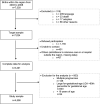Maternal socioeconomic and lifestyle factors and life dissatisfaction associated with a small for gestational age infant. The Survey of Neonates in Pomerania (SNiP)
- PMID: 35599250
- PMCID: PMC10023753
- DOI: 10.1007/s00404-022-06598-x
Maternal socioeconomic and lifestyle factors and life dissatisfaction associated with a small for gestational age infant. The Survey of Neonates in Pomerania (SNiP)
Abstract
Purpose: The aim is to investigate the associations of the mother's socioeconomic and lifestyle factors and life satisfaction with the delivery of a small for gestational age (SGA) infant.
Methods: Data from 4598 participants of the population-based birth cohort study Survey of Neonates in Pomerania (SniP) including comprehensive information on pregnancies, mothers, and their offspring in Western Pomerania, Germany were used in this study. The associations were analyzed using linear and logistic regression models.
Results: After logistic regression analysis adjusted for height of the mother, women who delivered SGA infants, had lower education (p < 0.01) and smoked more frequently during pregnancy (p < 0.01) compared with mothers of adequate for gestational age (AGA) neonates. A mother with less than 10 years of education and one who continued smoking during pregnancy had an odds ratio (OR) of 2.23 [95% confidence interval (CI) = 1.44 to 3.46] and 2.68 (95% CI = 2.06-3.49) of having an SGA infant, respectively. There was no association between the employment of the mother (p = 0.28), the monthly income (p = 0.09), the family status (p = 0.80), the number of friendships outside the household that the mother would not wish to relinquish (p = 0.47), the number of people that she could rely on in case of an emergency (p = 0.75), or alcohol consumption prior to (p = 0.14) or during the pregnancy (p = 0.99) with SGA. Finally, women who delivered SGA infants were more frequently dissatisfied with their employment (p = 0.03) and financial status (p < 0.01).
Conclusions: Women who delivered SGA infants had more associated socioeconomic and lifestyle risk factors and were more frequently dissatisfied with their life conditions than mothers of AGA neonates.
Keywords: Fetal growth restriction; Infant; Pregnancy; Risk factors; Small for gestational age; Smoking in pregnancy; Socioeconomic status.
© 2022. The Author(s).
Conflict of interest statement
Financial interests: HJ Grabe has received travel grants and speakers honoraria from Fresenius Medical Care, Neuraxpharm, Servier and Janssen Cilag as well as research funding from Fresenius Medical Care. M Heckmann has received speaker honoraria from Baxter and Chiesi. All other authors have no relevant financial or non-financial interests to disclose.
Similar articles
-
Movin' on Up: Socioeconomic Mobility and the Risk of Delivering a Small-for-Gestational Age Infant.Matern Child Health J. 2016 Mar;20(3):613-22. doi: 10.1007/s10995-015-1860-5. Matern Child Health J. 2016. PMID: 26541591 Free PMC article.
-
Intergenerational Cohort Study of Preterm and Small-for-Gestational-Age Birth in Twins and Singletons.Twin Res Hum Genet. 2015 Oct;18(5):581-90. doi: 10.1017/thg.2015.60. Epub 2015 Sep 2. Twin Res Hum Genet. 2015. PMID: 26330196
-
Pregnancy Induced Hypertension Versus Small Weight for Gestational Age: Cause of Neonatal Hematological Disorders.Clin Lab. 2018 Jul 1;64(7):1241-1248. doi: 10.7754/Clin.Lab.2018.180302. Clin Lab. 2018. PMID: 30146849
-
Antenatal Corticosteroids and Outcomes of Small-for-Gestational-Age Neonates.Obstet Gynecol. 2016 Nov;128(5):1001-1008. doi: 10.1097/AOG.0000000000001674. Obstet Gynecol. 2016. PMID: 27741177
-
The associations of birth intervals with small-for-gestational-age, preterm, and neonatal and infant mortality: a meta-analysis.BMC Public Health. 2013;13 Suppl 3(Suppl 3):S3. doi: 10.1186/1471-2458-13-S3-S3. Epub 2013 Sep 17. BMC Public Health. 2013. PMID: 24564484 Free PMC article. Review.
Cited by
-
Comparison of fetal growth patterns from Western India with Intergrowth-21st.PLoS One. 2024 Oct 14;19(10):e0310710. doi: 10.1371/journal.pone.0310710. eCollection 2024. PLoS One. 2024. PMID: 39401220 Free PMC article.
-
Prevalence of adolescent pregnancy and evaluation of pregnancy outcomes: a retrospective study.Arch Gynecol Obstet. 2025 May;311(5):1351-1358. doi: 10.1007/s00404-025-07931-w. Epub 2025 Jan 20. Arch Gynecol Obstet. 2025. PMID: 39828776 Free PMC article.
-
The role of genetic testing in small for gestational age infants.J Perinatol. 2025 Jun 26. doi: 10.1038/s41372-025-02343-9. Online ahead of print. J Perinatol. 2025. PMID: 40571843 Review.
-
Risk factors for small for gestational age as defined by a birthweight z-score below minus one: A prospective observational study.Med Res Arch. 2024 Aug;12(8):5731. doi: 10.18103/mra.v12i8.5731. Epub 2024 Aug 29. Med Res Arch. 2024. PMID: 40098994 Free PMC article.
-
Integrated care for multi-domain vulnerability during pregnancy: a retrospective cohort study.Arch Womens Ment Health. 2025 Aug;28(4):699-709. doi: 10.1007/s00737-024-01554-x. Epub 2025 Jan 17. Arch Womens Ment Health. 2025. PMID: 39825035 Free PMC article.
References
-
- Nations U . The millennium development goals report 2013. New York: United Nations; 2013.
Publication types
MeSH terms
LinkOut - more resources
Full Text Sources
Miscellaneous


